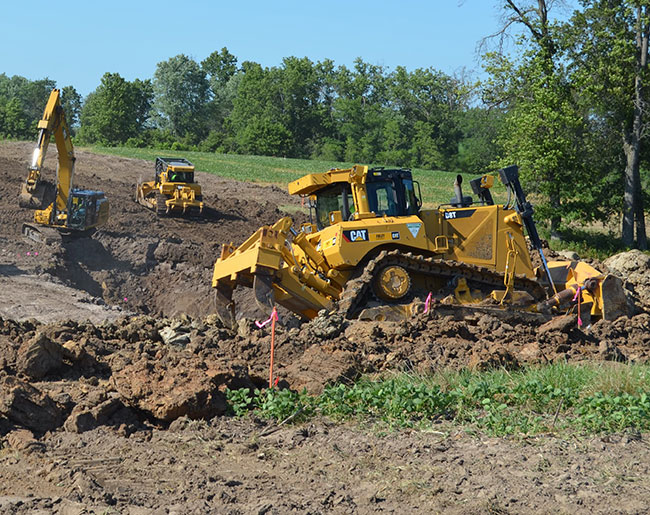
Features
Guest Column
LICA’s view: A proud tradition
October 10, 2023 By Chris Wagner, LICA, board chair

The Land Improvement Contractors of America is honored to be part of Drainage Contractor’s 50-year anniversary. Drainage is the foundation upon which LICA was built.
In 1938 a group of terrace contractors in Missouri got together to form the Missouri Terracing and Conservation Contractors Association. In 1948 the Michigan Farm Trenchers Association was formed. Contractors in Iowa and Minnesota in 1949 formed the Midwest Drainage and Soil Conservation Contractor Association, and in 1952 the Kansas Conservation Contractor Association was formed. All of this led to the creation of the National Land Improvement Contractors of America in February of 1952. State chapters continued to be added through the 20th century and LICA keeps expanding today.
LICA has been dedicated to the conservation of land and water for 71 years. LICA members have been instrumental in the development of new drainage techniques, technological adaptations to drainage equipment, GPS, laser technology, and the never ending research into better procedures and conservation efforts. The accomplishments of individual LICA members in the drainage industry are too long to list here, but they can be found in the LICA publication, The History of Farm Drainage and the LICA Contractor. LICA contractors and State Chapters continue to work with State and Federal administration offices to address the ongoing demands of drainage and environmental concerns.
Drainage has been one of the most important industries in this nation, if not the most Important. As the country moved west and the population exploded, feeding the people was paramount to the expansion of the United States. One of the greatest drainage accomplishments ever was the drainage of the Great Black Swamp in northwest Ohio and northeast Indiana in the second half of the 1800’s. It was done to provide better transport to the West, but more importantly, to create more land to grow food. Today we face an increasing need to produce food as our own domestic, and the world’s populations continue to grow, which means we need to make more land available for agriculture.
While the conservation of land and water is the heart of LICA, safety is its soul. I was fortunate to attend the Pennsylvania LICA State Chapter Conference in February and was both saddened and encouraged by two seminars I attended. I was saddened by the drainage and trenching accidents that were discussed. Encouraged by the incredible passion presented to eliminate accidents. I discovered that as we are expanding the land we need to grow food, we are looking to farmland that is very rural and undeveloped. Many pipes and transition lines were buried in this land years ago. Some we know about; others we do not. More importantly, we do not know how deep they are.
We all work in an extremely dangerous industry. If you have never seen the film produced by Drain Tile Safety Coalition titled Three Seconds Later, I suggest you find it and watch it, but not with your children present.
The accident described happened not so much from negligence but from the unknown on land where things were buried years ago.
We all call 811 for mark outs, but that does not produce depth locations. Today, we continually install drainage five to six feet deep or deeper. Many pipelines and transition lines are at that depth, and many were buried years ago in land that was never expected to be developed and certainly did not expect to have drainage pipe installed at those depths. Nature has changed the depth of those lines. We can no longer assume pipe depths based on our own historical experiences.
The Drain Tile Safety Coalition pointed out that depth of pipes and lines can be determined. It is a more extensive pre-excavation procedure. It requires more planning, more lead time, and more dealing with government agencies that we would rather not contact.
However, our responsibility is not just to the water and soil, but to the safety of ourselves, our employees, our families and their families. Does this require more planning and time on our part? Yes. Do we need to do it? I will let you answer that after you watch the film.
The second seminar that moved me was given by Monica Rakoczy of Entertraining Solutions. It is entitled “Everybody, Anybody, Somebody, and Nobody.” If you ever have the opportunity to attend one of Monica’s safety seminars or classes, make sure you attend. The premise of the presentation is actually incredibly simple. It is that we, all of us on site, the ones with experience, the ones that have seen what can happen on a site, the ones who know better, are responsible for on-site safety. Not just the safety guy, also the safety book, the safety toolbox talks, the daily morning safety meetings, but all of us. Do not just say to a new guy, “Do not do that.” Tell him/her why. Tell them what could happen and unfortunately what you have seen happen. Be a storyteller. Be the Somebody, not the Anybody or the Nobody. Let us forget the line, “You learn by your mistakes.”
We are responsible for transforming the earth, for providing the food and infrastructure required now and in the future. Drainage Contractor and LICA will continue to be at the forefront of the industry. Let us do it with due diligence and safety. Let us celebrate our history. And as we look forward, let us not only protect the land and the water, but more importantly, our employees, our employees’ families, our families and ourselves. DC
Print this page